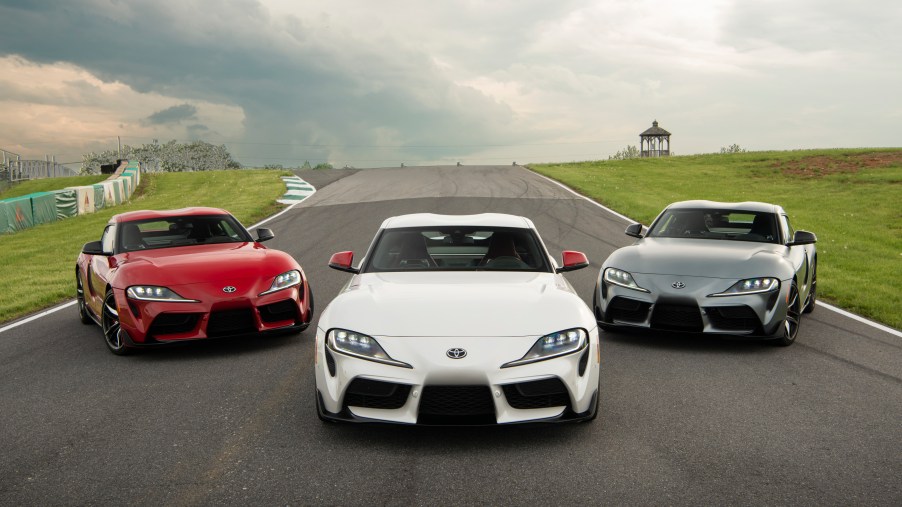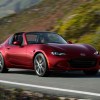
The 10 Fastest Toyota Cars of All Time
Toyota’s most popular cars tend to be practical, reliable models that get good gas mileage. But just because the RAV4 has proven to be one of the top-selling vehicles in the U.S., that doesn’t mean the Japanese automaker has completely abandoned the performance market, either. Let’s take a look at the Toyota cars with the fastest 0-to-60 mph times that we could find.
Corolla Mk V – AE86
For its time, the Mk V Corolla was an absolute monster of a car. It was made famous by Initial-D, a series depicting the rich and vibrant history of Japanese downhill racing. The 86 was able to overcome even Nissan GT-R skylines by virtue of its immensely light body and exemplary cornering capabilities.
The 1.8-liter 136 hp inline-four 4A-GE capped out at 7600 RPM, allowing drivers to enter and exit corners at very high rev rates without losing top-end power, thanks to VTEC predecessor variable valve timing.
The 86 had an advertised top speed of 125 miles per hour, just 17 miles per hour slower than the 1992 MR2 Turbo. It reached 60 mph from a dead stop in just 8.5 seconds.
Tacoma TRD Pro
The Tacoma, a light-duty truck with four-wheel drive capability, is capable of reaching 0-to-60 times in the range of 7.0-7.5 seconds. This is exceptionally quick, considering the truck is powered by the same 3.5L V6 as the Camry. The Tacoma weighs in at around 2,000 pounds heavier. It does, however, allow for greater utility than many of the other vehicles in our list.
Camry SE V6
The Camry SE V6 pumps out 260 hp, with a 2019 XSE reaching upward of 300 horsepower. The 2019 XSE has a top speed of 135 miles per hour and a 0-to-60 time just over 7 seconds. The Camry SE V6 was one of the most powerful Toyota cars at its inception, however, boasting 0-to-60 times around 7 seconds while most cars of the era settled around 10 seconds for their 0-to-60 runs.
Camry Solara SE Sport
The Camry Solara was a slightly slower and more affordable version of the Camry SE V6 which relied on a 3.3-liter V6 power plant, putting over 200 hp to the ground, the Solara SE Sport could scoot from zero-to-60 in 6.9 seconds.
Celica GT-Four
The peak of the Celica line, a GT-Four was powered by a 2.0-Liter inline-four cylinder engine, producing more than 200 hp with a turbo. The GT-Four was made famous in the 1995 WRX Rally series due to an ingenious design which effectively allowed them to cheat by bypassing the restrictor plate. They were banned from the final 1995 race and all of the 1996 races.
The GT-Four remains one of the best-performing cars from Toyota in the 1994 range, which also saw superstars such as the MR2 Turbo and Mk IV twin-turbo Supra, the Celica’s big brother. The little brother made a name for itself with a 6.3-second 0-to-60 time.
MR2 Turbo
The MR2 Turbo started its life as a race car, pushing 260 horsepower and boasting a 6.2 second 0-to-60 time, this JDM beast stoked the burning in the hearts of a generation of JDM gearheads. Toyota canceled the MR2 Turbo from the Firestone Firehawk Series in 1992, but the improvements they made as a result of these races led to the wildly successful street variant.
Toyota 86
The Toyota eight-six has been made infamous by Initial D, though this vehicle bears no major resemblance to the iconic AE86 Trueno. The modern 86 is powered by a Subaru boxer four-cylinder with just a hair over 200 hp. Making the run from 0-to-60 in 6.2 seconds, it’s not the quickest car you can buy. But it sure is fun to drive.
Avalon XLE
The Toyota Avalon XLE uses a 3.5-liter V6 and puts out over 260 hp. Seeking to excite younger audiences, the Avalon has developed a higher performance profile than its predecessors. The 2019 XLE provides fewer creature comforts in exchange for a noisier, sportier ride. It rolls to 60 mph in just 6.1 seconds. Considering its lack of a turbo, that time is actually quite impressive for a vehicle under $40,000.
Supra Mk IV Twin-Turbo
When the fourth-generation Supra was being developed, Japanese automakers were taxed according to displacement, so Toyota improvised, using a twin sequential turbo setup with one of the greatest engines of all time to create a sports car which still holds as one of the most feared and respected machines on the street.
The 2JZ GTE has been measured against the Nissan RB and Ford Barra inline-six engines, though the competition is slim. The 2JZ GTE is widely renowned as an engineering marvel for many reasons. Some of the most notable reasons include its tapered cylinders, Siamese bore, and internal oiling mechanics. The 2JZ could return nearly double the oil of an RB, preventing oil trapping in the head.
Commonly running several hundred thousand miles, the 2JZ was much more prone to blow out turbos than experience core component failure, even when being tuned to over 800 hp with stock internal components. Did we mention it could run from 0-to-60 in under five seconds stock?
2020 Supra
The 2020 Supra has disappointed gearheads everywhere, utilizing a BMW-engineered 3.0-liter power plant. This power plant propels the 2020 Supra from 0-to-60 in 3.8 seconds.
Despite the lack of a Toyota-built successor to the throne of the 2JZ, the 2020 Supra delivers excellent handling and impressive acceleration. Only time will tell if the new Supra can be tuned like the Mk IV, or if it will become the ultimate engine swap shell for 2JZ owners everywhere.


